Busan Motor Show serves up a handful of futuristic cars
07 Jun 2016|8,674 views
This is Korea's automotive industry gearing up in the second biggest city, Busan, as it hosted the 2016 Busan International Motor Show (BIMOS) at BEXCO.
Under the theme 'Future Wave, Inspiring Technology', the biennial motor show showcased over 200 vehicles from 25 domestic and foreign brands. The annual motor show is held alternately in Seoul and Busan. While popular and luxurious brands such as Audi, Bentley, BMW, Maserati, Toyota and Volkswagen were present, apart from staple Korean carmakers Hyundai and Kia, brands like Ferrari, Honda, Lamborghini, Mitsubishi and Ssangyong did not take part in the show.
Still, according to organiser, Busan Metropolitan City, a total of more than 2,800 booths that were operated by 180 automobile companies from 11 countries took part at the show.
Here are some of the highlights at this year's BIMOS:
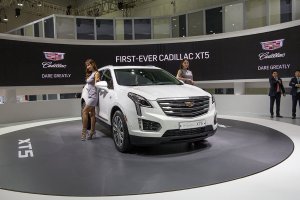 Cadillac XT5
Cadillac XT5Local importer, Alpine Group, brought in two models of the Cadillac back in 2010, one of which was the Cadillac CTS that sported a 3.6-litre V6 that was capable of 309bhp and 370Nm of torque. Unfortunately, it never really took off in Singapore.
If it did, it wouldn't come as a surprise if the Cadillac XT5 comes to our shores. Measuring 4,815mm long, 1,905mm wide and 1,705mm tall, the SUV replaces the SRX and is placed somewhere between the BMW X3 and the X5.
At launch, the XT5 is equipped with an eight-speed autobox that's nicely married to a 3.6-litre V6 engine that's good for 314bhp and 365Nm of torque.
Like the BMW X5, the century sprint is only completed in some 6.5 seconds.
 Chevrolet Camaro SS
Chevrolet Camaro SSRevealed at the Chevy booth, the all new Camaro SS has a dramatic and boldly sculpted sheet metal that screams everything performance.
Residing underneath its bonnet is an all new 6.2-litre V8 engine that generates a whopping 455bhp and a mountain-moving 617Nm of twisting force, making it the most powerful Camaro SS ever created. These figures are sent to the wheels via an eight-speed automatic transmission.
According to Chevrolet, the muscle car offers advanced technologies such as variable valve timing, direct injection and active fuel management to better manage efficiency as well as performance.
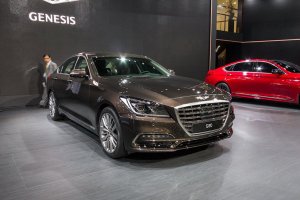 Genesis G80
Genesis G80Hyundai's Genesis sedan has undergone an update for the 2017 model year, and has been moved over to the new Genesis luxury brand.
Dubbed the Genesis G80, the car made its world debut at the show, alongside the Genesis G80 Sport as well as the New York Concept car, which the new G70 could be based on. With the debut of these cars, it can be safely assumed that Hyundai Motor Group is on a mission to nurture the Genesis brand into a global luxury marque like Lexus.
Going head on with the Audi A6, the BMW 5 Series, the Lexus GS and the Mercedes-Benz E-Class, the G80 should be expected to arrive in Singapore sometime in November this year. Engine choices include a 3.3-litre V6 or a 3.8-litre V6, both of which are good for 282bhp and 315bhp respectively that are paired to an eight-speed automatic gearbox. However, specifications for Singapore's market have yet to be confirmed.
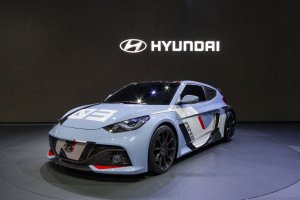 Hyundai RM16
Hyundai RM16This is undoubtedly the star of Hyundai's lineup and, admittedly, also the show. Project RM, which stands for Racing Midship, aims to develop high-performance technologies while focusing on performance. The RM model has developed with a 'rolling lab' concept since 2014, playing a key role in research and development of high performance future 'N' models from Hyundai Motor.
The 'N' models for Hyundai is equaivalent to what AMG is to Mercedes-Benz and what M is to BMW. Sources from Hyundai management did mention that they are focusing on compact hatchbacks and one of the selected models that would be converted to 'N' would be the Hyundai i30.
Inheriting characteristics from the earlier RM14 and RM15 models, the RM16 will be equipped with a six-speed manual transmission and midship-mounted 2.0-litre Theta T-GDI engine that will churn 300bhp. Additionally, the concept car boasts the same sports-focused weight distribution of 43 percent front and 57 percent rear, as its predecessors.
Also present at the show at Hyundai's booth was the Hyundai N 2025 Vision Gran Turismo, the i20 WRC car, the Ioniq Hybrid and the Ioniq Electric car.
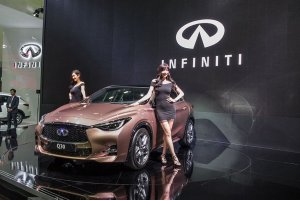 Infiniti Q30
Infiniti Q30Unveiled at its booth was the same car that had its world premiere at the Frankfurt Motor Show last year. Going against luxury rivals such as the Audi A3 Sportback, the BMW 1 Series and the Mercedes-Benz A-Class, the Infiniti Q30 shares the same underpinnings, engines and components as the A-Class.
The premiere of the Infiniti hatchback comes exactly two years after its precursor, the Q30 Concept, was introduced at the 2013 Frankfurt show. The unmistakable approach of that concept has been fully maintained as Infiniti's all new compact vehicle is introduced to the market, making it one of the most attractive-looking cars in its segment.
Blessed with a 208bhp-rated 2.0-litre powerplant, power is sent to the front wheels via a seven-speed automatic transmission. The car is expected to arrive on our shores in the second half of this year.
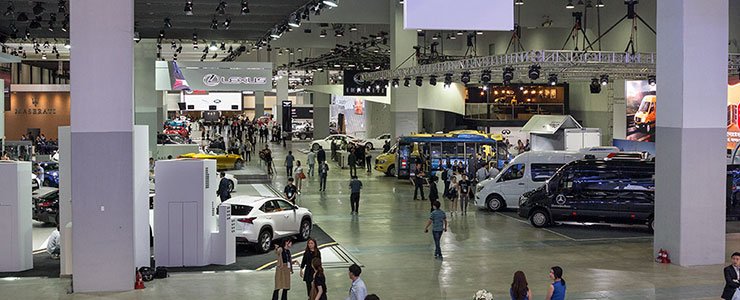 |
The Busan Motor Show, while interesting, lacks the potential to become the equivalent of more recognised motor shows such as the ones held in Geneva or Tokyo. However, the show will undoubtedly set the trends for the domestic car market in Korea.
Moving towards futuristic and advanced tech cars such as fully electric as well as plug-in hybrid cars, Korean giants Hyundai and Kia are pumping out cars that will not only cut down on carbon emissions but also improve in its high-performance division.
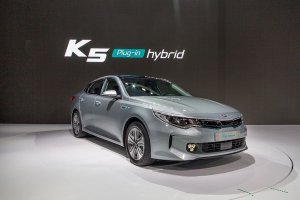 Kia K5 Plug-in Hybrid
Kia K5 Plug-in HybridAlso unveiled at the Chicago Auo Show early this year, the Kia K5 Plug-in Hybrid (PHEV) was shown alongside the carmaker's growing lineup of eco-friendly vehicles, including the all new Niro Hybrid Utility Vehicle (HUV), the Kia K7 Hybrid (HEV) as well as the Kia Soul Electric Vehicle (EV).
Utilising Kia's highly efficient 2.0-litre 'Nu' four-cylinder GDI engine that's mated to a six-speed automatic transmission, power output is targeted at 154bhp. Electric power is produced by a transmission-mounted 50kW motor while the battery system features a 9.8 kWh lithium-ion polymer battery pack. Thus, the total driving range of the PHEV is estimated to be at about 965km. In full EV mode, the car is good for 43km of driving.
The Optima PHEV is equipped with a single charging port conveniently located in the driver's side front fender. A full charge can be achieved in less than three hours or nine hours via a 240V or a 120V socket respectively.
 Lexus GS450h F Sport
Lexus GS450h F SportTaking centre stage at the Lexus booth was the Lexus GS450h F Sport, alongside famliar cars such as the GS F, the RC F, the NX, the RX as well as the LF-C2 concept.
Measuring 4,880mm x 1,840mm x 1,455mm (L x W x H) and with a wheelbase of 2,855mm, the GS Hybrid's 3.5-litre V6 engine that's good for a combined output of 340 horses and 352Nm of torque is mated to an e-CVT, which should help a fair bit in the car's fuel efficiency.
0-100km/h is completed in 5.9 seconds, sugnificantly faster than the 7.3-second timing for the GS Turbo.
While the car has already arrived in Singapore, arrangement for test drives hasn't started yet. Stay tuned for more updates on this car.
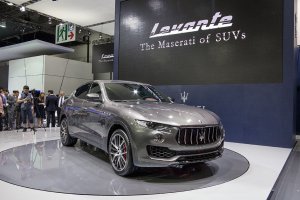 Maserati Levante
Maserati LevanteThis is Maserati's first Sports Utility Vehicle (SUV) in more than 100 years of the brand's history. It was first unveiled to the world at this year's Geneva Motor Show and has now made its way to the Busan show.
Going against the likes of the BMW X5 and the Porsche Cayenne, three different variants are available - Levante, Levante S as well as the Diesel - all of which are powered by a 3,0-litre V6 powerplant. The output of the base model sees 350 Italian horses from 5,750rpm and 500Nm of torque while the diesel-powered car churns out some 275bhp from just 4,000rpm and a dizzying 600Nm of twisting force. The top-of-the-range Levante S, on the other hand, has a heavy 430bhp and some 580Nm of torque from the word go, which allows the car to propel from 0-100km/h in just 5.2 seconds before hitting s top speed of 264km/h.
While the Maserati Levante is expected to come to Singapore sometime end of this year or the first quarter of next, rumour has it that shipment of the car could be delayed due to unforseen circumstances of a change of local dealership.
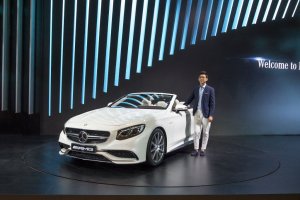 Mercedes-Benz S 63 AMG Cabriolet
Mercedes-Benz S 63 AMG CabrioletWe have seen the S 63 AMG Coupe and there isn't much difference with the cabriolet version, except for the removable top.
Performance figures remain the same at 585bhp and 900Nm of torque from the 5.5-litre V8 engine, which will allow the car to accelerate from nought to 100km/h in a respectable 4.3 seconds flat.
The difference in driveability, we suspect, is the slightly more obvious external noise intrusion due to its retractable top.
For the local market, the S 63 AMG Cabriolet will be available only on an indent basis in the fourth quarter of 2016.
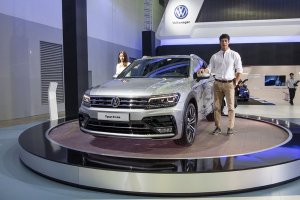 Volkswagen Tiguan
Volkswagen TiguanTried and tested in Berlin, Germany, the Volkswagen Tiguan is thd first new Volkswagen Sport Utility Vehicle (SUV) that's based on the efficient and flexible MQB platform. Thus, dimensions have changed rather significantly over the outgoing model.
The new model here sees an increase of 30mm in width and 60mm in length and a reduction of 33mm in height, with a bigger wheelbase of 77mm, giving this compact SUV a whole lot more of road presence that was missing before.
There's a total of three petrol and two diesel engine range. Locally, we can expect a 1.4 TSI DSG variant to hit Volkswagen's showroom by the end of this year. And as usual, the car will be equipped with a creamy smooth seven-speed dual-clutch transmission. Whether or not the 180bhp-rated All-Wheel Drive 2.0-litre TSI will be coming remains to be seen.
This is Korea's automotive industry gearing up in the second biggest city, Busan, as it hosted the 2016 Busan International Motor Show (BIMOS) at BEXCO.
Under the theme 'Future Wave, Inspiring Technology', the biennial motor show showcased over 200 vehicles from 25 domestic and foreign brands. The annual motor show is held alternately in Seoul and Busan. While popular and luxurious brands such as Audi, Bentley, BMW, Maserati, Toyota and Volkswagen were present, apart from staple Korean carmakers Hyundai and Kia, brands like Ferrari, Honda, Lamborghini, Mitsubishi and Ssangyong did not take part in the show.
Still, according to organiser, Busan Metropolitan City, a total of more than 2,800 booths that were operated by 180 automobile companies from 11 countries took part at the show.
Here are some of the highlights at this year's BIMOS:

Cadillac XT5
Local importer, Alpine Group, brought in two models of the Cadillac back in 2010, one of which was the Cadillac CTS that sported a 3.6-litre V6 that was capable of 309bhp and 370Nm of torque. Unfortunately, it never really took off in Singapore.
If it did, it wouldn't come as a surprise if the Cadillac XT5 comes to our shores. Measuring 4,815mm long, 1,905mm wide and 1,705mm tall, the SUV replaces the SRX and is placed somewhere between the BMW X3 and the X5.
At launch, the XT5 is equipped with an eight-speed autobox that's nicely married to a 3.6-litre V6 engine that's good for 314bhp and 365Nm of torque.
Like the BMW X5, the century sprint is only completed in some 6.5 seconds.

Chevrolet Camaro SS
Revealed at the Chevy booth, the all new Camaro SS has a dramatic and boldly sculpted sheet metal that screams everything performance.
Residing underneath its bonnet is an all new 6.2-litre V8 engine that generates a whopping 455bhp and a mountain-moving 617Nm of twisting force, making it the most powerful Camaro SS ever created. These figures are sent to the wheels via an eight-speed automatic transmission.
According to Chevrolet, the muscle car offers advanced technologies such as variable valve timing, direct injection and active fuel management to better manage efficiency as well as performance.

Genesis G80
Hyundai's Genesis sedan has undergone an update for the 2017 model year, and has been moved over to the new Genesis luxury brand.
Dubbed the Genesis G80, the car made its world debut at the show, alongside the Genesis G80 Sport as well as the New York Concept car, which the new G70 could be based on. With the debut of these cars, it can be safely assumed that Hyundai Motor Group is on a mission to nurture the Genesis brand into a global luxury marque like Lexus.
Going head on with the Audi A6, the BMW 5 Series, the Lexus GS and the Mercedes-Benz E-Class, the G80 should be expected to arrive in Singapore sometime in November this year. Engine choices include a 3.3-litre V6 or a 3.8-litre V6, both of which are good for 282bhp and 315bhp respectively that are paired to an eight-speed automatic gearbox. However, specifications for Singapore's market have yet to be confirmed.

Hyundai RM16
This is undoubtedly the star of Hyundai's lineup and, admittedly, also the show. Project RM, which stands for Racing Midship, aims to develop high-performance technologies while focusing on performance. The RM model has developed with a 'rolling lab' concept since 2014, playing a key role in research and development of high performance future 'N' models from Hyundai Motor.
The 'N' models for Hyundai is equaivalent to what AMG is to Mercedes-Benz and what M is to BMW. Sources from Hyundai management did mention that they are focusing on compact hatchbacks and one of the selected models that would be converted to 'N' would be the Hyundai i30.
Inheriting characteristics from the earlier RM14 and RM15 models, the RM16 will be equipped with a six-speed manual transmission and midship-mounted 2.0-litre Theta T-GDI engine that will churn 300bhp. Additionally, the concept car boasts the same sports-focused weight distribution of 43 percent front and 57 percent rear, as its predecessors.
Also present at the show at Hyundai's booth was the Hyundai N 2025 Vision Gran Turismo, the i20 WRC car, the Ioniq Hybrid and the Ioniq Electric car.

Infiniti Q30
Unveiled at its booth was the same car that had its world premiere at the Frankfurt Motor Show last year. Going against luxury rivals such as the Audi A3 Sportback, the BMW 1 Series and the Mercedes-Benz A-Class, the Infiniti Q30 shares the same underpinnings, engines and components as the A-Class.
The premiere of the Infiniti hatchback comes exactly two years after its precursor, the Q30 Concept, was introduced at the 2013 Frankfurt show. The unmistakable approach of that concept has been fully maintained as Infiniti's all new compact vehicle is introduced to the market, making it one of the most attractive-looking cars in its segment.
Blessed with a 208bhp-rated 2.0-litre powerplant, power is sent to the front wheels via a seven-speed automatic transmission. The car is expected to arrive on our shores in the second half of this year.The Busan Motor Show, while interesting, lacks the potential to become the equivalent of more recognised motor shows such as the ones held in Geneva or Tokyo. However, the show will undoubtedly set the trends for the domestic car market in Korea.
Moving towards futuristic and advanced tech cars such as fully electric as well as plug-in hybrid cars, Korean giants Hyundai and Kia are pumping out cars that will not only cut down on carbon emissions but also improve in its high-performance division.

Kia K5 Plug-in Hybrid
Also unveiled at the Chicago Auo Show early this year, the Kia K5 Plug-in Hybrid (PHEV) was shown alongside the carmaker's growing lineup of eco-friendly vehicles, including the all new Niro Hybrid Utility Vehicle (HUV), the Kia K7 Hybrid (HEV) as well as the Kia Soul Electric Vehicle (EV).
Utilising Kia's highly efficient 2.0-litre 'Nu' four-cylinder GDI engine that's mated to a six-speed automatic transmission, power output is targeted at 154bhp. Electric power is produced by a transmission-mounted 50kW motor while the battery system features a 9.8 kWh lithium-ion polymer battery pack. Thus, the total driving range of the PHEV is estimated to be at about 965km. In full EV mode, the car is good for 43km of driving.
The Optima PHEV is equipped with a single charging port conveniently located in the driver's side front fender. A full charge can be achieved in less than three hours or nine hours via a 240V or a 120V socket respectively.

Lexus GS450h F Sport
Taking centre stage at the Lexus booth was the Lexus GS450h F Sport, alongside famliar cars such as the GS F, the RC F, the NX, the RX as well as the LF-C2 concept.
Measuring 4,880mm x 1,840mm x 1,455mm (L x W x H) and with a wheelbase of 2,855mm, the GS Hybrid's 3.5-litre V6 engine that's good for a combined output of 340 horses and 352Nm of torque is mated to an e-CVT, which should help a fair bit in the car's fuel efficiency.
0-100km/h is completed in 5.9 seconds, sugnificantly faster than the 7.3-second timing for the GS Turbo.
While the car has already arrived in Singapore, arrangement for test drives hasn't started yet. Stay tuned for more updates on this car.

Maserati Levante
This is Maserati's first Sports Utility Vehicle (SUV) in more than 100 years of the brand's history. It was first unveiled to the world at this year's Geneva Motor Show and has now made its way to the Busan show.
Going against the likes of the BMW X5 and the Porsche Cayenne, three different variants are available - Levante, Levante S as well as the Diesel - all of which are powered by a 3,0-litre V6 powerplant. The output of the base model sees 350 Italian horses from 5,750rpm and 500Nm of torque while the diesel-powered car churns out some 275bhp from just 4,000rpm and a dizzying 600Nm of twisting force. The top-of-the-range Levante S, on the other hand, has a heavy 430bhp and some 580Nm of torque from the word go, which allows the car to propel from 0-100km/h in just 5.2 seconds before hitting s top speed of 264km/h.
While the Maserati Levante is expected to come to Singapore sometime end of this year or the first quarter of next, rumour has it that shipment of the car could be delayed due to unforseen circumstances of a change of local dealership.

Mercedes-Benz S 63 AMG Cabriolet
We have seen the S 63 AMG Coupe and there isn't much difference with the cabriolet version, except for the removable top.
Performance figures remain the same at 585bhp and 900Nm of torque from the 5.5-litre V8 engine, which will allow the car to accelerate from nought to 100km/h in a respectable 4.3 seconds flat.
The difference in driveability, we suspect, is the slightly more obvious external noise intrusion due to its retractable top.
For the local market, the S 63 AMG Cabriolet will be available only on an indent basis in the fourth quarter of 2016.

Volkswagen Tiguan
Tried and tested in Berlin, Germany, the Volkswagen Tiguan is thd first new Volkswagen Sport Utility Vehicle (SUV) that's based on the efficient and flexible MQB platform. Thus, dimensions have changed rather significantly over the outgoing model.
The new model here sees an increase of 30mm in width and 60mm in length and a reduction of 33mm in height, with a bigger wheelbase of 77mm, giving this compact SUV a whole lot more of road presence that was missing before.
There's a total of three petrol and two diesel engine range. Locally, we can expect a 1.4 TSI DSG variant to hit Volkswagen's showroom by the end of this year. And as usual, the car will be equipped with a creamy smooth seven-speed dual-clutch transmission. Whether or not the 180bhp-rated All-Wheel Drive 2.0-litre TSI will be coming remains to be seen.
Thank You For Your Subscription.

















































